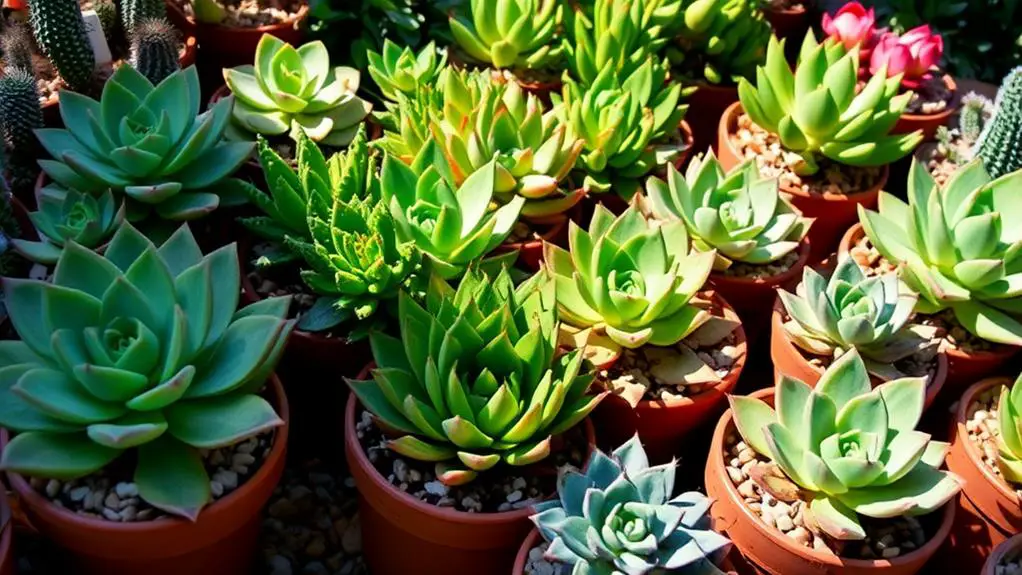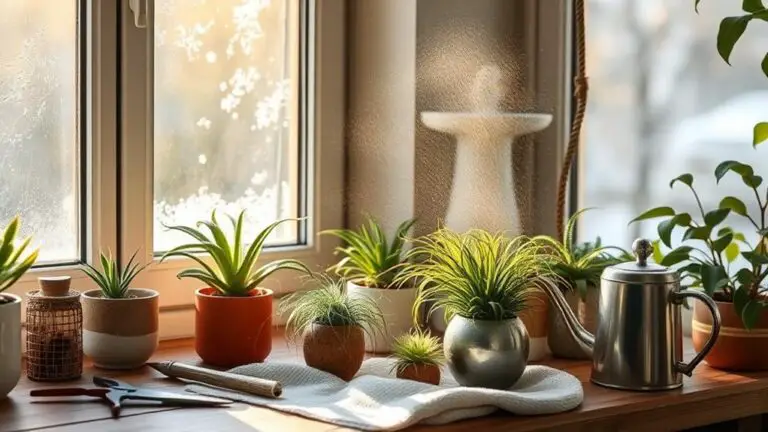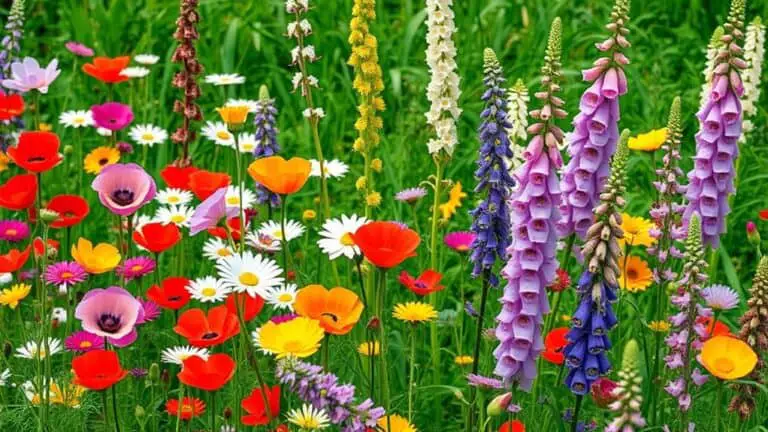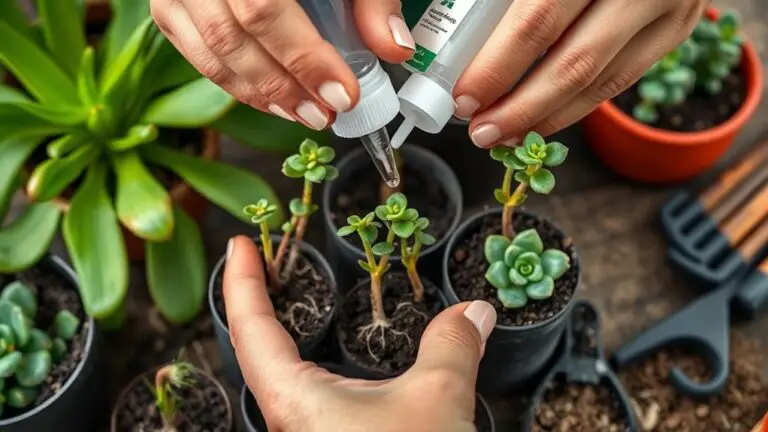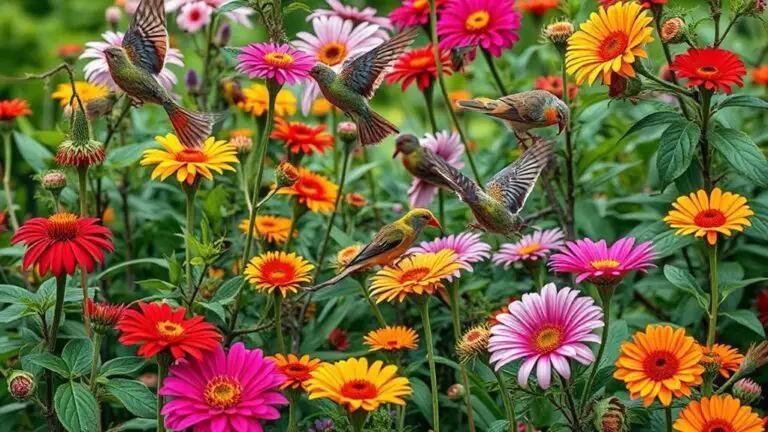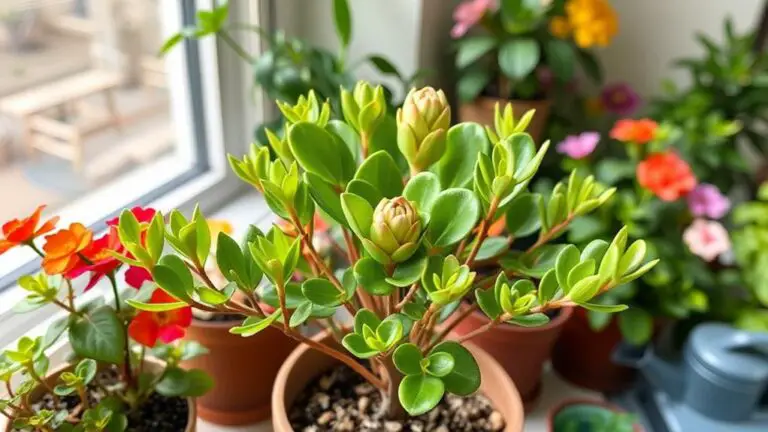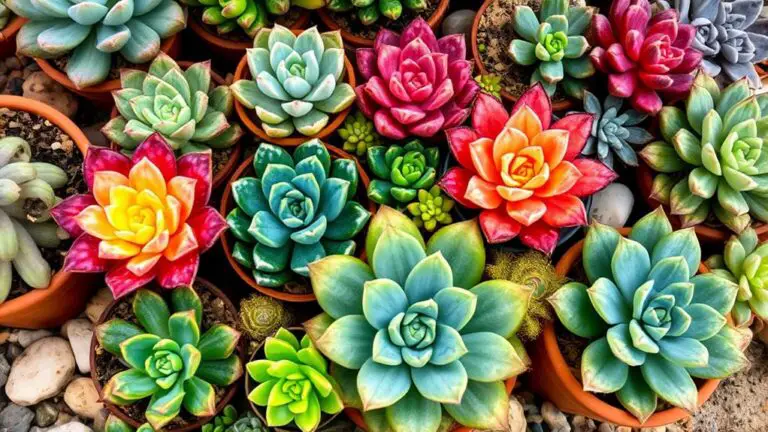10 Tips for Selecting Healthy Succulents
When you're on the hunt for healthy succulents, it's vital to focus on a few key factors to guarantee your new plants thrive. Start by feeling the leaves; they should be firm and plump, not soft or mushy, which can indicate overwatering. Next, take note of the leaf color—vibrant hues are often a sign of good health, while faded or discolored leaves might suggest underlying issues. Don't forget to inspect for physical damage and pests hiding on the leaf undersides. Curious about what else to look for? Let's explore more essential tips to help you make the best selection.
Inspect Leaf Firmness
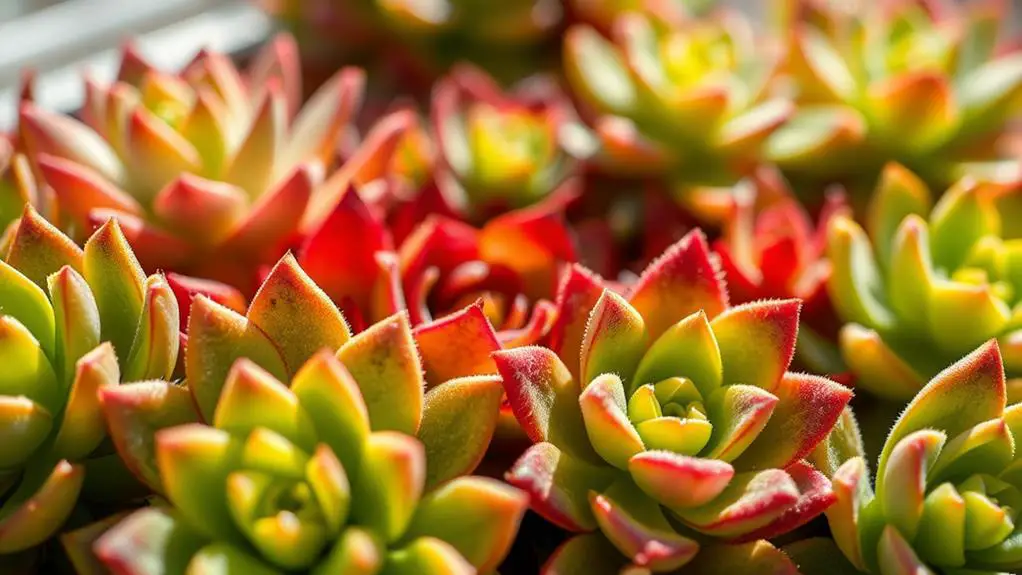
When caring for succulents, it's crucial to inspect the firmness of their leaves to guarantee they're healthy. Healthy succulents should have firm, plump leaves. If you gently squeeze the leaves and they feel mushy or soft, it's a clear indication of overwatering and poor health. Overwatering is a common mistake in succulent care. To keep your plants thriving, you need to be attentive to these signs.
Dark brown or blackened leaf tips often suggest a combination of overwatering and insufficient care. This signals the need for immediate adjustment in your watering routine. Succulent leaves shouldn't be squishy or waterlogged. Instead, they should be vibrant and plump, without wrinkles or signs of dehydration.
To help with succulent care, consider using a moisture meter. This tool can assist you in evaluating soil moisture, ensuring that you're not overwatering. By regularly checking the firmness and overall appearance of your succulent's leaves, you can catch problems early and make necessary changes.
This simple practice will help you maintain healthy, beautiful plants. Remember, paying attention to the firmness of the leaves is key to successful succulent care.
Evaluate Leaf Color
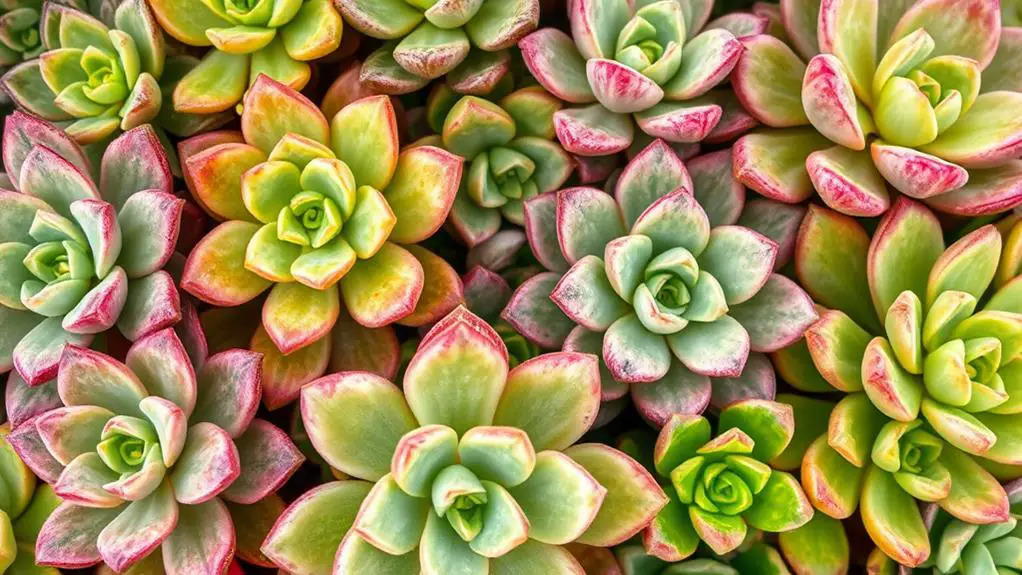
Monitoring the firmness of succulent leaves is just one part of ensuring your plants stay healthy; evaluating leaf color is equally important. Healthy succulents typically show off vibrant, rich colors. If your succulent's leaves look pale or faded, it might be a sign of stress or not enough light.
Dark green leaves usually mean the plant is used to low light conditions, while those with more color need more sunlight to keep their hues bright. Check for leaves that are too dark, as this could mean they've too many chloroplasts from not enough light. This can hurt the plant's overall health and growth.
Discolored leaves, especially yellow or brown ones, can indicate over-watering or a lack of nutrients. Always look for signs of healthy growth, like firm and plump leaves. If the leaves look shriveled or feel mushy, the plant could be in distress and may need better care.
Check for Physical Damage
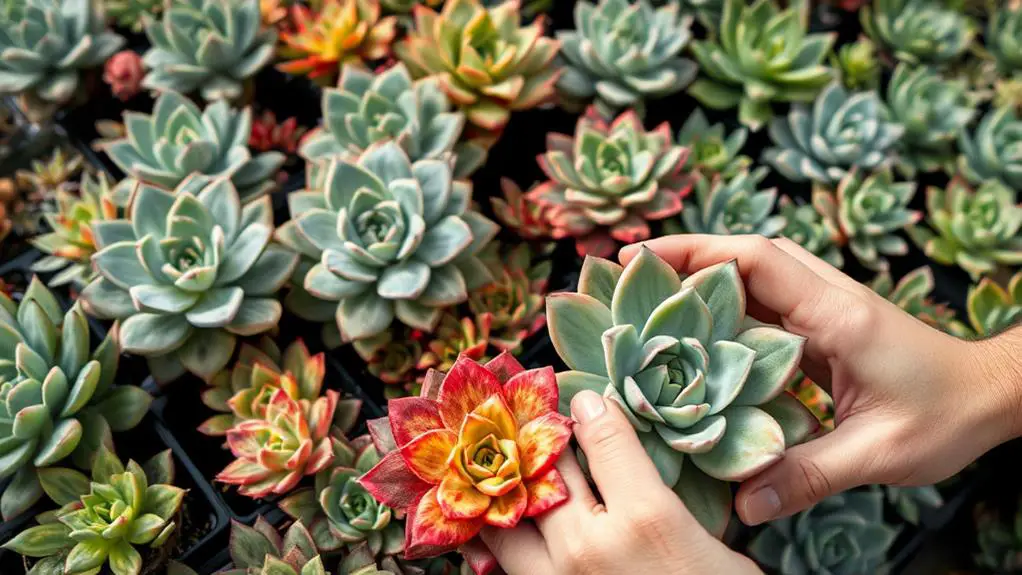
Inspecting your succulents for physical damage is essential for maintaining their health. When you're checking your plants, start by examining the leaves closely. Look for any bumps, scars, or tears. These might indicate stress or poor health.
Firmness is another key factor; if the leaves feel mushy, it could be a sign of overwatering, which might lead to rot. You should also be on the lookout for discoloration or unusual spots, as these can signal pest infestations or disease.
A succulent's leaves should stay intact when you touch them; if they fall off easily, that could mean overwatering or root issues. Finally, healthy succulents should appear full and perky, without any signs of wilting or drooping, which can suggest distress.
Here are some specific things to look for:
- Bumps, scars, or tears: Signs of stress or damage.
- Firmness: Mushy leaves could mean overwatering and potential rot.
- Discoloration or spots: Possible pest infestations or disease.
- Leaf integrity: Leaves falling off easily may indicate root problems.
- Overall appearance: Full, perky plants without wilting or drooping show health.
Taking these steps helps guarantee your succulents stay healthy and vibrant.
Assess Growth Rate

Understanding the growth rate of your succulents is essential for guaranteeing they thrive in your indoor environment. Slow-growing succulents maintain a more attractive appearance in low light conditions. They don't stretch towards the light, avoiding weak, elongated stems. This makes them great choices for indoor spaces where light may be limited.
Cacti from the Aizoaceae family are excellent examples of slow-growing varieties that thrive indoors. If you're looking for healthy succulents that are easy to manage, these are a perfect pick.
On the other hand, fast-growing succulents can be a bit tricky. They might develop elongated stems and weak leaves if they don't get enough light, which can make them look less appealing.
When choosing succulents, assess the growth rate to guarantee it matches your indoor environment. Healthy succulents should look full and perky. This indicates that their growth rate is appropriate for their light conditions and care regimen.
Look for Pests
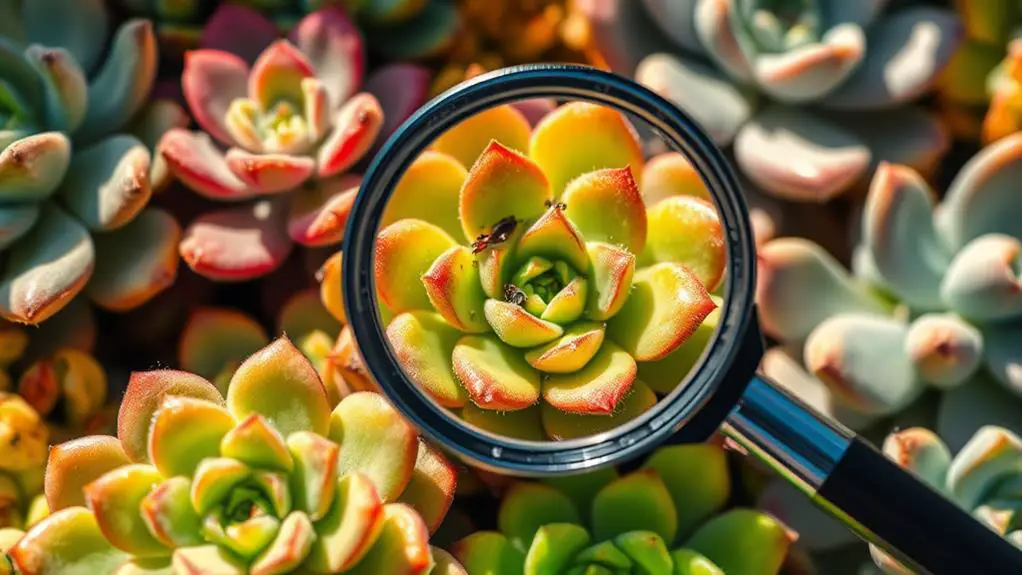
When checking your succulents for pests, start by inspecting the undersides of the leaves for tiny webs, which could mean spider mites are present.
Look closely for small black or brown spots, as these might be insect droppings or signs of aphids.
Make sure to examine the soil surface and the base of the plant for any hidden pests that might be causing distress, such as yellowing leaves.
Check for Webs
As you care for your succulents, make it a habit to check for webs, which could be a sign of spider mites, a common pest in dry conditions.
Inspect the leaves and stems closely for any visible webs. These pests can be small and might hide in hard-to-see areas.
Look for tiny black or brown spots on the leaves. These spots can be insect droppings, often found near webs, indicating the presence of pests.
It's important to regularly examine the base of the plant too. Hidden pests can sometimes be concealed in the soil or among the roots, making them harder to detect but potentially more damaging to your succulents.
If you notice any signs of pest infestation, notify nursery staff immediately. They can provide guidance and assist with treatment options to help you manage the problem effectively.
Here are some key points to remember:
- Inspect leaves and stems for visible webs.
- Look for tiny black or brown spots on leaves.
- Regularly check the base of the plant for hidden pests.
- Notify nursery staff if you find any pests.
- Consistent checking helps catch infestations early.
Inspect Leaf Undersides
While checking for webs and other signs of pests on the surface of your succulents, don't forget to inspect the undersides of the leaves as well. This is where many pests like to hide.
When you inspect leaf undersides, you might find webs, which are a sign that the plant could have spider mites. Also, keep an eye out for tiny black spots, which are often insect droppings from pests like aphids or mealybugs.
Sticky residues on the leaf undersides can also be a sign of pest activity. These residues often come from sap-sucking insects that excrete honeydew.
Discolored or damaged leaves are another red flag. These symptoms can indicate that pests are compromising your plant's health. Regularly inspecting the undersides of leaves helps catch infestations early, which can prevent widespread damage and keep your succulent thriving.
If you do find pests, let the nursery staff know. They can offer assistance or treatment options, helping you avoid bringing infested plants into your home.
Examine Soil Surface
Don't overlook the soil surface when checking your succulents for pests. It's essential to inspect this area carefully since many problems start there.
Look closely for tiny black or brown spots, which can indicate insect droppings or infestations. Seeing these signs early can help you take action before the problem worsens.
Here are some specific things to watch for:
- Insect Droppings: Small black or brown spots on the soil can be a sign of pests.
- Webs: Spider mites or other pests might leave webs on the soil surface or around the plant base.
- Gnats: These pesky insects are often found in overwatered soil and can spread quickly.
- Soil Texture: Compacted or water-logged soil can harbor pests and cause root rot.
- Regular Checks: Inspect the soil and surrounding area regularly to catch issues early.
Examine Soil Condition
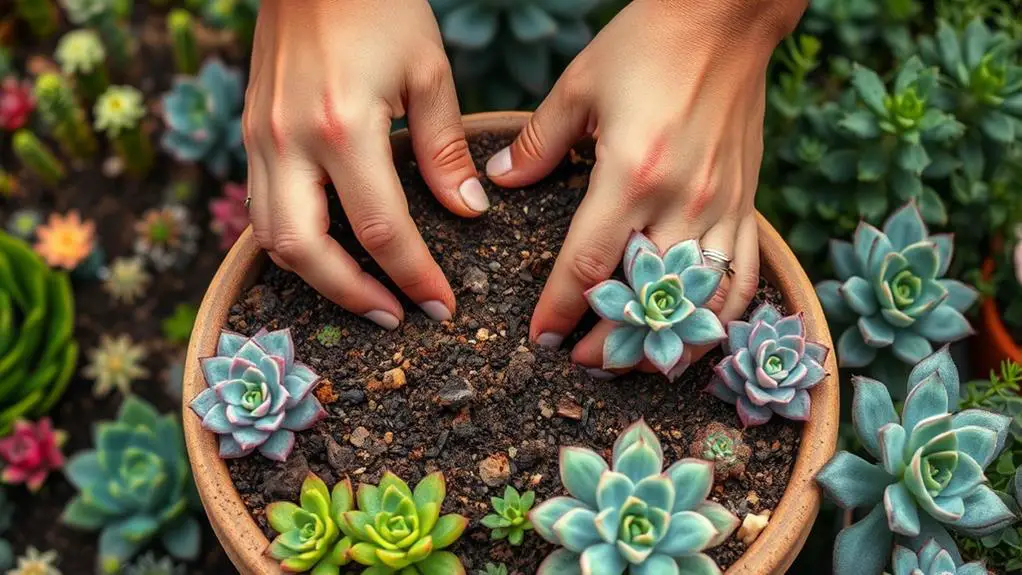
To keep your succulents healthy, it's important to examine the soil condition.
Make sure you're using well-draining soil to prevent root rot and allow excess moisture to escape.
Also, keep an eye on the soil moisture; it should be dry to the touch, especially in the top inch, before you water again.
Check Soil Drainage
Guaranteeing proper soil drainage is essential for maintaining healthy succulents. Without it, your plants can suffer from water-logged soil, which suffocates the roots and promotes bacterial growth. This can lead to serious health issues for your succulents.
To guarantee your succulents thrive, consider these tips:
- Choose a well-draining soil mix: A blend of equal parts soil, sand, peat moss, and perlite provides ideal aeration and prevents water retention.
- Feel the soil's texture: It should be loose and crumbly, not compacted. This helps the roots breathe and prevents too much moisture from being trapped.
- Inspect for root rot: Signs include a foul smell or discolored, mushy roots. These indicate poor drainage and can severely harm your plant.
- Select containers with drainage holes: These allow excess water to escape, preventing the soil from becoming too wet.
- Check the top inch of soil: If it feels wet, the moisture level might be too high, putting your succulent at risk of overwatering.
Assess Soil Moisture
While ensuring proper soil drainage is essential, the next step is to consistently assess soil moisture to maintain your succulents' health. Start by checking the top inch of soil. It should feel dry before you water again to prevent overwatering. Overwatering is a common mistake that can damage your plants.
To be more precise, you can use a moisture meter. This tool helps you get accurate readings, ensuring that your succulents are thriving in well-draining soil that isn't waterlogged.
Healthy soil for succulents should be loose and airy. This allows water to drain quickly and prevents the roots from suffocating. Regularly inspect the soil condition to make sure it's not compacted or heavy, as this can hinder root growth and water drainage.
Keep an eye out for yellow or brown leaves, which can indicate improper soil moisture levels. These signs may point to either overwatering or under-watering issues.
Avoid Painted Plants
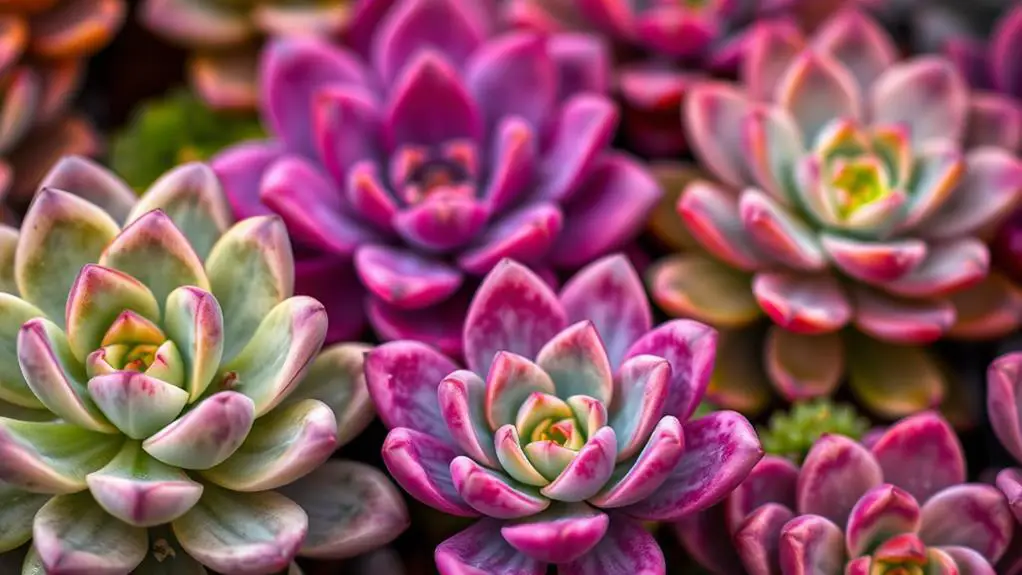
Ever wondered why painted succulents are a bad idea? Painted plants may look colorful and unique, but they come with hidden risks that can harm your succulents.
The spray paint used on these plants often contains harmful chemicals. These chemicals can damage or even kill your beloved succulents.
The paint can suffocate the plant's leaves, preventing them from performing essential functions like gas exchange and photosynthesis. This means your plant can't "breathe" or make its food, leading to its decline.
Instead of opting for painted plants, choose unpainted succulents to guarantee you're starting with a healthy specimen that can thrive under your care.
Here are some key reasons to avoid painted succulents:
- Harmful chemicals: Spray paint can contain toxins that damage the plant.
- Suffocation: Paint blocks the leaves, stopping gas exchange and photosynthesis.
- Ethical gardening: Supporting natural beauty promotes healthier gardening practices.
- Healthier choices: Unpainted plants are more likely to thrive.
- Informed decisions: Inspect plants for paint residue to guarantee they're healthy.
Consider Light Requirements

When picking succulents, make sure you know their light needs.
Colorful ones often need up to 6 hours of direct sunlight each day, while greener types can handle more shade.
Gradually introduce your plants to direct sunlight to prevent sunburn and help them thrive.
Optimal Sunlight Exposure
Understanding the light requirements for your succulents is key to keeping them healthy and vibrant. Ideal sunlight exposure plays an essential role in their growth and color. Many succulents need up to 6 hours of direct sunlight daily. This proper light exposure enhances their vibrant hues and supports robust growth.
However, gradual acclimatization is vital to prevent sunburn, especially when moving plants from shaded areas to direct sunlight.
Green to dark green varieties like Aloe Vera and Haworthias can tolerate lower light conditions well. They won't stretch or become unattractive due to less light. On the other hand, colorful succulents need more sunlight to maintain their bright colors. If they don't get enough light, they can become leggy, stretching towards the light source.
Proper light exposure is essential for overall plant health. Inadequate lighting can lead to weak stems, poor growth, and a higher risk of infestations.
Here are some tips to guarantee your succulents get the right amount of light:
- Place succulents in a spot with bright, indirect sunlight.
- Gradually increase their exposure to direct sunlight over time.
- Rotate your plants regularly to guarantee even light distribution.
- Monitor for signs of sunburn or stretching.
- Adjust light conditions based on the season and plant needs.
Shade-Tolerant Varieties
Shade-tolerant succulents, like Aloe Vera, Gasterias, and Haworthias, are perfect for indoor spaces with limited sunlight. These plants thrive in low light conditions, making them ideal for spots where sunlight is scarce.
You'll notice their dark green leaves, a sign of their ability to photosynthesize efficiently even with less light. This makes them a great choice for keeping your indoor garden healthy and vibrant without needing direct sunlight.
While colorful succulents need bright light to maintain their hues, shade-tolerant varieties can do well with just 4 to 6 hours of indirect light each day. This means you can place them in a north-facing window or a room with filtered light, and they'll still flourish.
Slow-growing succulents, including some cacti from the Aizoaceae family, are especially suited for low light, keeping a neat form and structure over time.
When selecting healthy shade-tolerant succulents, look for firm, perky leaves without discoloration or distress. This indicates they can handle lower light conditions well.
Review Watering Needs
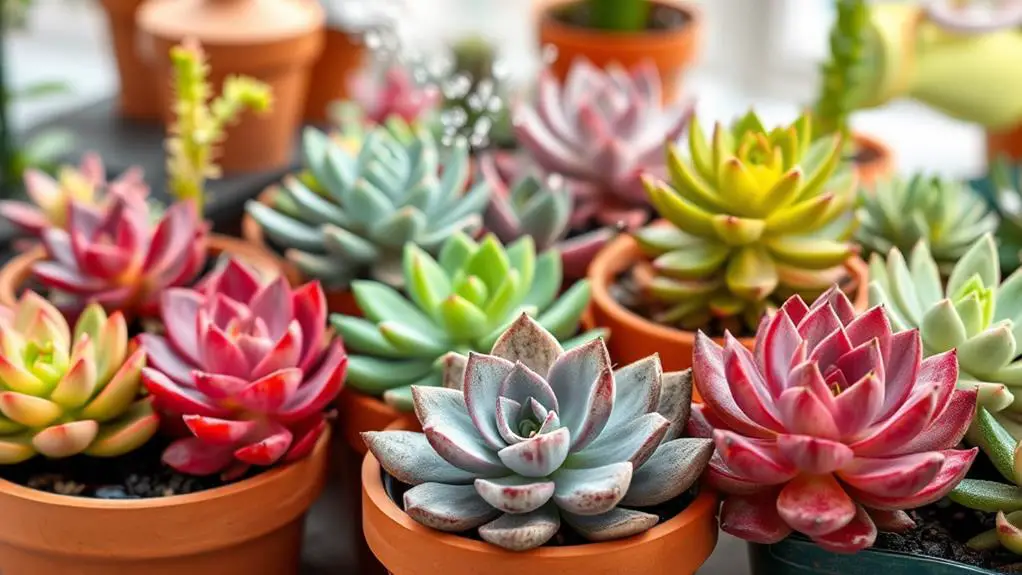
For thriving succulents, it's crucial to master their watering needs. Succulents are unique because they store water in their leaves, allowing them to survive in dry conditions. However, they still need a proper watering schedule to stay healthy.
Start by letting the top half-inch of soil dry out completely before re-watering. This prevents overwatering and root rot.
During colder months, when temperatures drop below 40°F, most succulents need less water. Their water needs decrease considerably, so be sure to water them less frequently.
Mimic natural rainfall patterns with intermittent but generous watering. This guarantees their roots get enough moisture without becoming waterlogged.
Using a moisture meter can help you accurately assess soil moisture levels. This tool can be very helpful in preventing over or under-watering your succulents.
Remember, avoid watering them in cold conditions, as water can pool in the soil and increase the risk of bacterial infections.
Here are some key points to remember:
- Let the top half-inch of soil dry out before watering.
- Reduce watering in colder months.
- Mimic natural rainfall patterns.
- Use a moisture meter to check soil moisture.
- Avoid watering in cold conditions.
Choose Pet-Safe Varieties
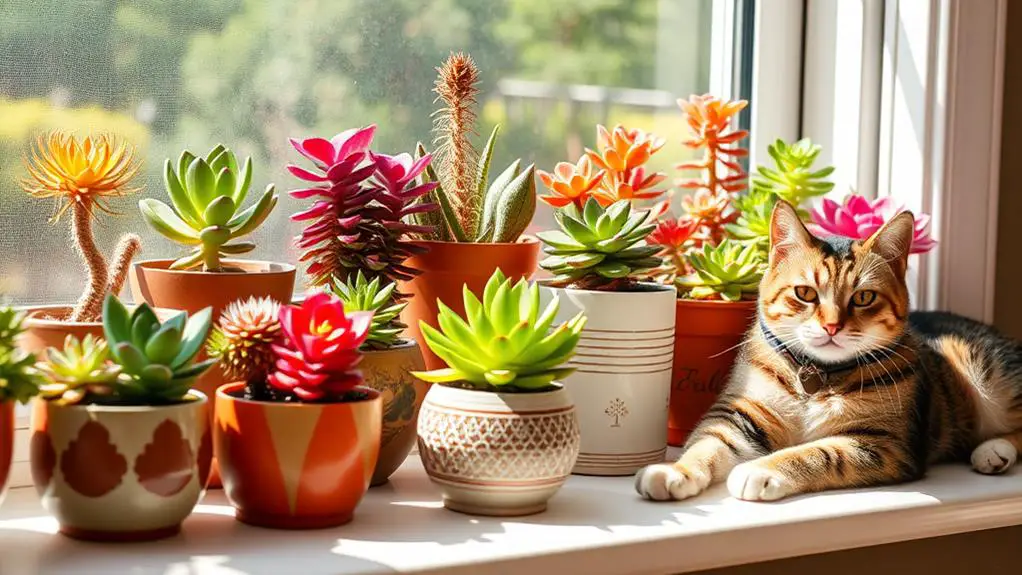
When selecting succulents, many options are both beautiful and safe for pets. It's important to choose pet-safe varieties that are non-toxic to cats and dogs to guarantee your furry friends stay healthy.
Some great options include Haworthia, Echeveria, and Aloe Vera. These succulents not only look amazing but also provide peace of mind knowing your pets are safe.
Researching the ASPCA's list of toxic and non-toxic plants is a good step to take. This guarantees the succulents you pick won't harm your pets.
Many colorful succulents, like certain types of Echeveria, are also safe for pets. This way, you don't have to sacrifice beauty for safety.
Always inspect your plants for signs of distress or pests. Unhealthy plants can pose a risk if ingested by your pets.
Consider the placement of your succulents too. Even pet-safe plants can be hazardous if your pets are prone to chewing on them. Placing them out of reach can help prevent any mishaps.
Frequently Asked Questions
What Do Healthy Succulents Look Like?
Healthy succulents have perky, firm leaves that stand upright and vibrant colors. Avoid ones with bumps, scars, or fallen leaves. Use a moisture meter to check soil moisture, ensuring it's not over or under-watered.
How Do You Pick Succulents?
When picking succulents, inspect the leaves for firmness and vibrant color. Check for physical damage or pests under the leaves. Verify the plant's in a well-draining pot and avoid those with yellow or brown leaves.
How Do You Know if Succulents Are Unhealthy?
You'll know succulents are unhealthy if they have mushy, droopy leaves, discoloration, or visible damage. Check for pests and inspect soil moisture. Overly wet soil often indicates root rot. Look for these signs to guarantee plant health.
Should I Put Coffee Grounds in My Succulents?
You can use coffee grounds for your succulents, but don't overdo it. Mix them sparingly into the soil, about 10%. Make certain they're dry and free of additives to avoid mold and pests. Monitor soil acidity.
Conclusion
You've got this! By keeping an eye on leaf firmness, color, and growth rate, you'll pick the healthiest succulents around. Don't forget to check for pests and avoid painted plants. Pay attention to their light and watering needs, and choose pet-safe varieties. With these tips, you'll build a beautiful, thriving succulent garden. Trust yourself, and enjoy the process. Happy gardening!

